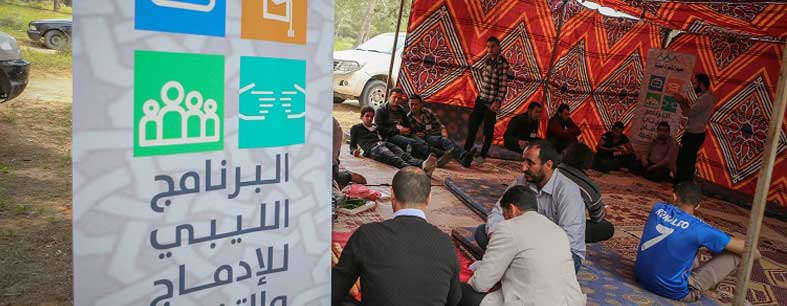In a shady wooded area on the outskirts of Sabratha, a group of 30 former Thuwar are gathering for a lecture. In the quiet cool of the pine trees, the 30 men, some of them in their early 20’s, are here to learn more about the importance of preserving Libya’s dramatic and astonishing heritage and artefacts.
Not that this is a new concept to them; many of these men, like Riad Ali Omar, volunteered to guard and protect Sabratha’s ancient historical sites from looters and damage during the revolution. “To preserve the history and heritage of our nation, our traditions and culture, is very important, and it is very important we protect what we have.”
Some of Libya’s – and even the world’s – most important and well preserved Roman historical sites are scattered along the country’s northern Mediterranean coastline, and not least the remarkably well preserved 3rd Century, three-story high open-air theatre.
As part of a Heritage Protection Project run by the Libyan Programme for Reintegration and Development (LPRD) Civic Empowerment Programme, the group will undergo a 3-day foundation course in Sabratha itself before embarking on a longer 45-day programme in Tripoli.
Adel Bin Wear, Thuwar commander in Sabratha during the Revolution and now head of the LPRD Sabratha Branch says that before the revolution Gadaffi viewed this place as nothing, it wasn’t important. “One day, the local commander of Gadaffi’s forces here in Sabratha came and took sections of wall from the site to use to build his house with, not because it was historical or important, but just because he could; he was the commander of Gadaaffi’s regime here, he could simply do what he wanted.”
Bin Wear continues that when Gadaffi was in control they didn’t know what had been taken, but during the revolution, when the former regime forces had fled, they went to that particular commander’s house and set about finding the stolen items and other heritage pieces. “With the new government we are now in the process of returning these and other historical pieces back to Sabratha.”
From his early childhood Bin Wear considered this heritage area part of his culture and has always taken a keen interest in it. “It is my honour to now contribute to it’s future preservation”, he says, a sentiment also shared by everyone attending the course, including Khaled Ahmed. “Before we just protected the area in any way we could, but now with this training and this course we hope to learn how to protect our own history for the future.”
Riad Ali Omar adds that during the revolution members of Gadaffi’s forces came to Sabratha’s historical sites with weapons and ammunition and that the regime would store guns, bombs and bullets in, around and very close to these places as they knew NATO would not bomb or strike close to the heritage areas.
The Thuwar themselves also avoided using heavy weapons in fighting for control of Sabratha, and once the battle had been fought and won and Gadaffi’s forces had left, many of these men now gathered, moved to protect the historical sites and artefacts from looting and any potential impact from fighting in the surrounding areas.
Conducting the lecture is Mohammed Bojala, Head of Sabratha Branch for the Ministry of Heritage and Antiquities. “The history of Sabratha and how to protect this area and the importance of this piece of Libya’s past is essential and I have advised them to enjoy this training to protect the country’s past in order to preserve it for the future.” Bojala says that during the course of the training they will go on to learn how to talk and interact with visitors, learn and narrate the history of the sites and artefacts in the Sabratha museum and talk about what is of interest. “It is important that people understand that they all have a role to play in preserving this site.”
As the sun lowers towards the horizon to the west of the magnificent Roman theatre, Bojala concludes on the importance of this part of Libya’s history. “It will be better for us and for young people, to learn more and more about our history, so it is very important to look after this area, it is our history and our heritage.

